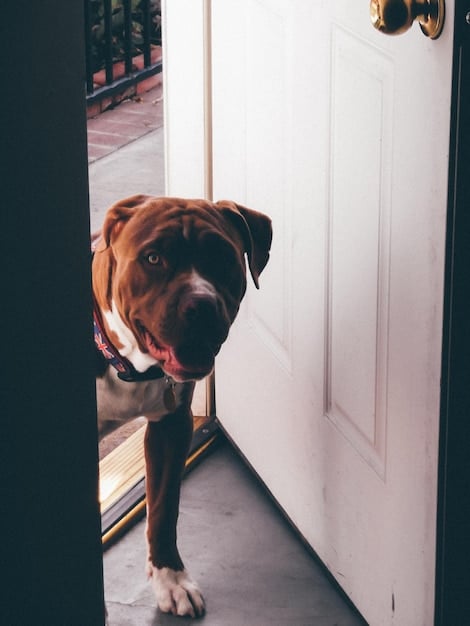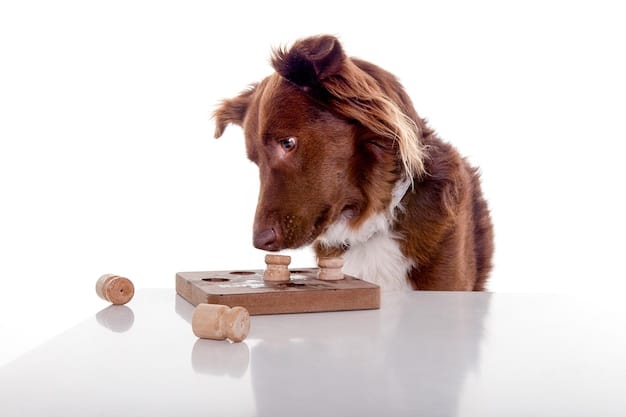Separation Anxiety Solutions: Calm Your Dog for 4 Hours Alone

Separation anxiety solutions for dogs focus on creating a sense of security and independence, helping them remain calm for up to 4 hours alone through training, environmental enrichment, and, in some cases, medication.
Does your furry friend turn into a whirlwind of anxiety the moment you step out the door? You’re not alone. Separation anxiety solutions are crucial for many dogs, and it’s possible to help your dog stay calm and content, even when left alone for up to 4 hours.
Understanding Separation Anxiety in Dogs
Separation anxiety is more than just a dog missing its owner. It’s a genuine psychological distress that can manifest in various destructive and distressing behaviors. Recognizing the signs is the first crucial step in finding effective separation anxiety solutions.
It is important to distinguish separation anxiety from simple boredom or lack of training. Dogs experiencing true separation anxiety exhibit a range of specific symptoms when left alone.
Common Signs of Separation Anxiety
Identifying these signs can help differentiate separation anxiety from other behavioral issues.
- Excessive Barking or Howling: This isn’t just a few barks; it’s persistent vocalization that disturbs neighbors.
- Destructive Behavior: Chewing furniture, scratching doors, or destroying personal items.
- Accidents in the House: Urinating or defecating even when the dog is house-trained.
- Pacing or Restlessness: Unable to settle down and constantly moving.
The key is to observe the behavior specifically when the dog is left alone, as these symptoms should intensify during your absence.

Creating a Safe and Comfortable Environment
A secure and comfortable environment can play a significant role in mitigating separation anxiety. Turning your home into a peaceful haven can make all the difference in your dog’s ability to stay calm when you’re gone. The goal is for your dog to perceive your home as a safe space, not a prison.
Many dog owners find that adjustments to the environment can provide comfort and reassurance to their dogs.
Designating a “Safe Zone”
Creating a special area where your dog feels secure is very important in addressing separation anxiety.
- Choose a quiet, comfortable space, like a crate or a corner of a room.
- Fill it with familiar items, such as their favorite bed, toys, and a blanket that smells like you.
- Make it accessible at all times, not just when you’re leaving.
- Associate the space with positive experiences, like treats and gentle petting.
This is where your dog is comfortable staying while you are gone.
Enrichment Activities for Alone Time
Providing activities that keep your dog entertained and engaged can distract them from your absence.
- Puzzle Toys: Toys that dispense treats as your dog solves the puzzle.
- Chew Toys: Long-lasting chews can keep them occupied and relieve anxiety.
- Background Noise: Calming music or a white noise machine can mask outside sounds that may trigger anxiety.
Rotate these items to keep the dog interested.
By providing a safe space and activities, you are helping them stay relaxed.
The Power of Gradual Desensitization
Gradual desensitization is a process of slowly exposing your dog to the triggers of their anxiety in a controlled manner. This separation anxiety solution helps them learn that your departures don’t always lead to prolonged absence, and that they are safe even when you’re not there. It requires patience, consistency, and careful observation of your dog’s reactions.
This method focuses on breaking down the anxiety-inducing process into smaller, manageable steps.
Simulating Departures
Start with short, simulated departures to get your dog used to your pre-departure routine.
- Pick up your keys, put on your coat, and open the door, but don’t leave.
- Repeat this several times a day, gradually increasing the duration of the routine.
- Reward calm behavior with treats and praise.
The objective here is to make these events ordinary and insignificant.
Short Absences
Next, start with very brief absences, gradually increasing the time you’re away.
- Begin with just a few seconds, then a minute, then five minutes.
- Monitor your dog’s behavior during these absences.
- If they show signs of anxiety, shorten the duration and try again later.
Progress slowly and steadily, ensuring that your dog remains calm at each stage.
By gradually desensitizing your dog to the cues and the act of you leaving, they can be kept calm and relaxed.

Training Techniques to Boost Confidence
A well-trained dog is often a more confident dog. Positive reinforcement training can build your dog’s self-assurance and teach them coping mechanisms for when you’re not around. Teaching basic commands and tricks provides mental stimulation and a sense of accomplishment, which can reduce anxiety levels. Remember, consistency is key; practice these exercises regularly.
Training is also a good outlet for their energy.
Basic Obedience Training
Reinforce basic commands like “sit,” “stay,” and “down.” These commands provide structure and can help calm your dog when anxiety starts to rise. Practice these commands daily, and reward your dog for compliance.
“Stay” Command Practice
The “stay” command can be particularly useful in managing separation anxiety. Start by having your dog stay for short periods, gradually increasing the duration. This helps them learn to be alone for longer periods without panicking.
Having a well trained dog gives them confidence.
Considering Medication and Supplements
In some cases, behavioral modification techniques alone may not be sufficient to address severe separation anxiety. When a dog’s anxiety is deeply ingrained or causing significant distress, medication or supplements may be necessary. Before resorting to these options, it’s crucial to consult with a veterinarian or a certified veterinary behaviorist. They can assess your dog’s specific needs and recommend the most appropriate course of treatment.
There are many reasons someone may resort to medication.
Types of Medications and Supplements
There are several medications and supplements that are sometimes recommended for separation anxiety.
- Anti-Anxiety Medications: Prescription medications, such as selective serotonin reuptake inhibitors (SSRIs) or tricyclic antidepressants (TCAs), can help regulate mood and reduce anxiety.
- Pheromone Therapy: Dog-appeasing pheromones can create a sense of calm and security.
- Herbal Supplements: Some herbal supplements, like chamomile or valerian root, are believed to have calming properties.
It is very important to consult with a vet before giving your dog medication.
Potential Side Effects
Be aware of the side effects from medication.
- Sedation: Many anti-anxiety medications can cause drowsiness or lethargy.
- Changes in Appetite: Some medications may affect your dog’s appetite.
- Gastrointestinal Issues: Upset stomach, diarrhea, or vomiting can occur.
If you detect any side effects, adjust medication as needed under professional medical advice.
In some cases, these medications are needed to ensure the dog is safe and comfortable.
Managing Your Own Anxiety
Dealing with a dog with separation anxiety can be emotionally challenging for owners. It’s natural to feel frustrated, guilty, or anxious yourself. However, it’s essential to manage your own emotions and approach the situation with patience and consistency. Your dog can sense your stress, which can exacerbate their anxiety.
It is important to be calm around your dog.
Staying Calm and Positive
Maintain a calm and positive demeanor around your dog. Avoid displaying signs of anxiety or frustration, as this can reinforce their own feelings of insecurity. Speak to your dog in a soothing voice and offer reassurance without being overly effusive.
Seeking Support
Don’t hesitate to seek support from friends, family, or a professional dog trainer. Sharing your experiences and challenges can help you feel less alone and provide valuable insights and advice. Remember, you’re not in this alone.
Being there for your dog can mean the world.
In conclusion, a calming attitude and getting support makes a difference during training.
| Key Point | Brief Description |
|---|---|
| 🏠 Safe Zone | Create a comfy, secure space with familiar items. |
| 🚶 Gradual Absence | Practice short departures, slowly increasing the time. |
| 🐾 Training | Teach basic commands for confidence and calm. |
| 💊 Meds/Supplements | Consult vet for medication or calming supplements. |
Frequently Asked Questions
▼
It varies by dog, but the goal is to help them stay calm for up to 4 hours. Start with very short periods and gradually increase the time as they become more comfortable and show signs of being more comfortable.
▼
While any dog can develop it, dogs adopted from shelters or those with a history of abandonment may be more susceptible. Also, dogs that have a higher dependency on their owner can develop this type of anxiety.
▼
Yes, changes in schedule, moving to a new home, or a new family member can trigger anxiety. Maintain a consistent routine and provide reassurance during these times to minimize any stress the dog can incur.
▼
Provide a safe space, offer a favorite toy, and speak in a soothing voice. Avoid excessive attention, which can reinforce the anxiety and make them think there is something wrong. Act normal and calm.
▼
If the anxiety is severe, causing destructive behavior, or not improving with training, it is important to consult a vet for guidance on all **separation anxiety solutions**. They can assess the situation and recommend medication if necessary.
Conclusion
Overcoming separation anxiety in dogs requires patience, consistency, and a multi-faceted approach. By creating a safe and comfortable environment, employing gradual desensitization techniques, and considering medication when necessary, you can significantly improve your dog’s well-being and help them stay calm for up to 4 hours alone.





